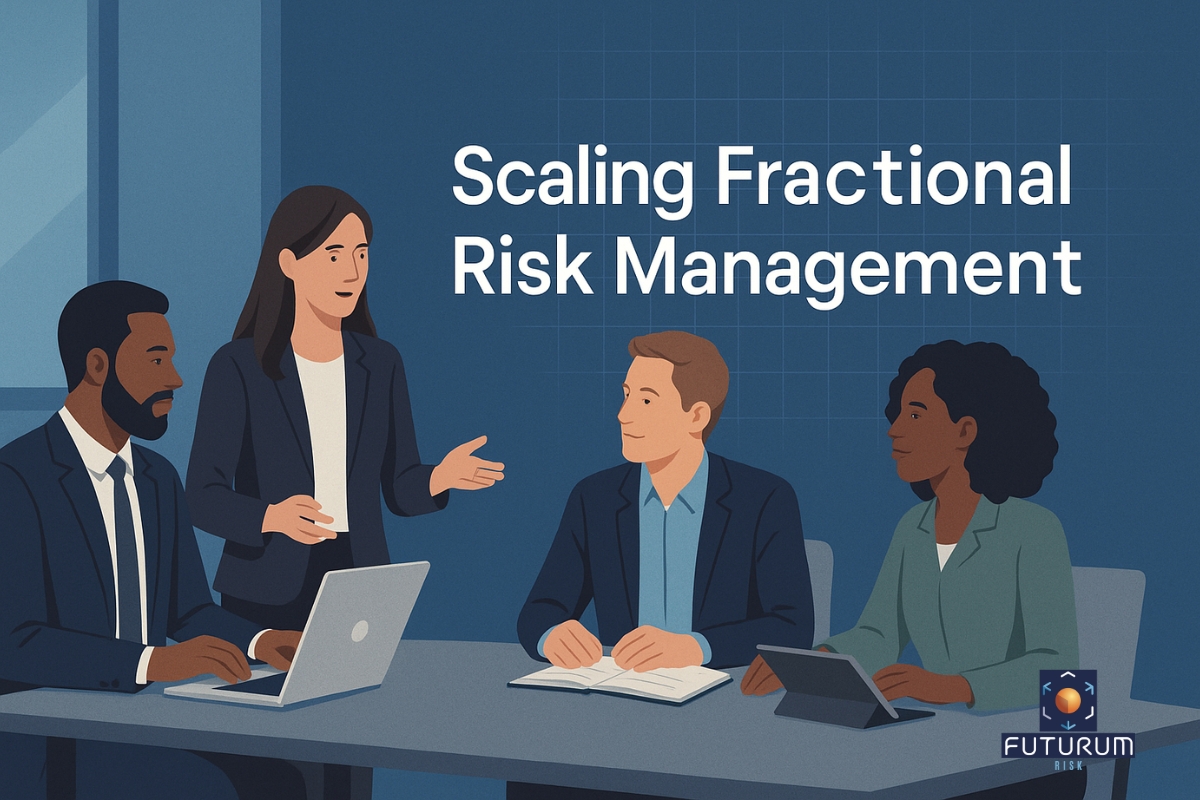Last week we explored what fractional risk management is. This week we turn to how it works in practice, how it scales with a business, and what impact it has when done well.
Scaling Fractional Risk Management: Turning Outsourced Expertise into Real Impact
Fractional risk management is more than another consulting model. It allows companies to bring in experienced risk professionals on demand, with exactly the right skills for the moment, without the overhead of building and maintaining a permanent team. The result is flexibility, expertise, and efficiency in equal measure.
Last week, we explored what fractional risk management is. This week, we turn to how it works in practice, how it scales with a business, and what impact it has when done well.
Why companies actually bring in fractional risk teams
The trigger for bringing in fractional support is rarely abstract. It is almost always a real and pressing business problem.
- A start-up about to raise capital realises its due diligence files are incomplete and investors will not take the risk.
- A scale-up is hiring at speed, but screening processes have not kept up, creating the chance of misconduct or fraud.
- A global client is waiting to be onboarded, yet compliance checks are slowing the deal.
- A leadership team recognises blind spots in areas such as cyber exposure, financial crime, or geopolitical instability, but no one inside the company has the expertise to manage them.
In these moments, fractional professionals provide stability. They parachute into the business, address immediate issues, and begin building the systems that will prevent the same risks from arising again. Unlike traditional consultants, they do not hand over a slide deck and leave. They integrate into the organisation, translate risk into commercial language, and help leaders turn uncertainty into structured decision-making.
Risk appetite: the foundation of fractional impact
Every organisation has a different tolerance for risk. This is known as risk appetite, and it determines how bold or cautious a company can afford to be. Risk appetite is not about eliminating risk but about directing it toward areas that generate value.
A technology company may accept aggressive product development timelines but refuse reputational risk linked to customer data. A financial institution may accept swings in the market but draw a hard line on compliance breaches. A healthcare provider may take on operational risks during expansion, but never compromise on patient safety.
The problem is that many leadership teams talk about being “risk aware” without defining what that actually means. This leaves managers guessing where boundaries lie. Fractional professionals bring objectivity. They run workshops, translate strategy into clear appetite statements, and design frameworks that guide real decisions.
When risk appetite is defined, decisions become consistent. Instead of asking “Does this feel risky?” managers ask “Does this align with our agreed appetite?”. That shift moves the debate away from personal opinion and anchors it in a shared framework.
Fractional teams also keep appetite alive. They revisit it as strategies evolve, ensuring the appetite grows alongside the business. Without this foundation, even the best-designed processes will lack direction.
How scaling works in practice
Fractional risk management is not a single engagement. It is a staged journey, with each phase adding maturity and resilience.
Stage 1: Quick fixes that matter
Most engagements start with urgent problems. A missing risk register. Vendor reviews that block deals. Recruitment pipelines that are too loose.
Fractional teams deliver visible wins within weeks. They set up a simple risk register that consolidates exposures in one place. They create a vendor vetting system that fast-tracks low-risk suppliers while scrutinising critical partners. They introduce employee screening that balances speed with assurance.
These actions prove credibility. Leaders see progress, staff see value, and the function begins to feel useful rather than theoretical.
Stage 2: Embedding into daily work
After stabilisation, the next step is integration. Risk is embedded into workflows rather than treated as a separate activity.
- Client onboarding does not proceed unless counterparty checks are cleared.
- Vendor contracts cannot be signed without supporting due diligence.
- Leadership meetings always include a risk update alongside financial and operational reviews.
Fractional professionals design these checkpoints to be proportionate. Low-risk suppliers may only need a form. High-risk vendors face deeper reviews. This balance keeps business moving while ensuring protection.
As systems embed, behaviour shifts. Risk is no longer a compliance add-on. It becomes part of the way work gets done.
Stage 3: Scaling to strategy
With processes in place, fractional teams help expand risk into strategic planning.
Financial due diligence evolves into structured deal memos, highlighting counterparty strength, deal structures, and mitigation plans. Cybersecurity extends beyond password discipline into penetration testing, monitoring, and response drills. Geopolitical assessments feed into decisions about expansion, partnerships, and supply chains.
Scaling does not mean adding layers of red tape. It means building resilience that matches the company’s growth.
Stage 4: Handing over and evolving
At maturity, fractional professionals shift roles. Daily operations move to permanent staff. External experts remain involved in oversight, benchmarking, and niche areas such as cyber, financial crime, or geopolitical analysis.
This stage depends on knowledge transfer. Playbooks, registers, and procedures must be documented and accessible. The aim is not to create dependency but to leave the organisation stronger and more self-sufficient than before.
The hidden benefits nobody talks about
Fractional risk management offers advantages that go beyond filling gaps.
- Cost efficiency: Companies only pay for what they need.
- Flexibility: Capacity can be scaled up for audits or expansion and reduced when pressure eases.
- Specialist access: Expertise in anti-financial crime one quarter and cybersecurity the next, without hiring permanent staff for both.
- Fresh perspective: External professionals spot blind spots internal teams may overlook, especially where culture or politics have created blind spots.
These advantages explain why fractional risk management is not just for start-ups. Even established companies use it to stay agile.
Common mistakes and how to avoid them
Fractional approaches can fail if leaders fall into certain traps.
- Seeing fractional support only as a temporary fix reduces its value to short-term problem-solving instead of long-term resilience.
- Failing to define the scope. Expecting complete coverage in limited hours is unrealistic.
- Allowing risk to live in reports rather than processes. If integration does not happen, impact will fade.
- Forgetting knowledge transfer. If expertise leaves with the external team, momentum is lost.
Avoiding these pitfalls ensures that fractional models stay credible.
Metrics that prove value
One challenge for any risk function is showing impact. Leaders want evidence, not just reports. Fractional teams focus on metrics that matter.
- Client onboarding times cut from weeks to days.
- Vendor reviews are completed within deadlines.
- Faster deal approvals with fewer disputes later.
- Incident response and recovery times are reduced.
- Audit findings are closed each quarter.
In the early stages, efficiency is the priority. As maturity grows, resilience and foresight take centre stage. Fractional professionals guide this progression.
Why fractional risk management is here to stay
Risk is only becoming more complex. Cyber threats, regulatory scrutiny, and global instability are now permanent features of the landscape. Building large, permanent risk teams is not viable for many companies.
Fractional risk management offers an alternative: senior expertise on tap, scalable with growth, and flexible to changing needs. It allows organisations to turn risk into a source of confidence rather than paralysis.
Done well, it is not a temporary fix. It is a smarter model for resilience and growth, combining external insight with internal ownership. For leaders navigating uncertainty, fractional risk management is a way to act decisively today while preparing for tomorrow.





